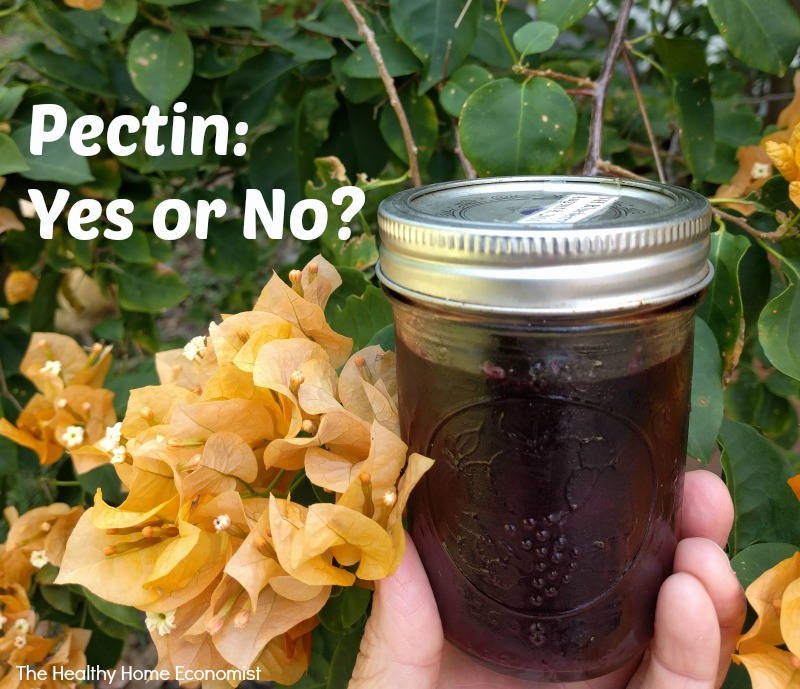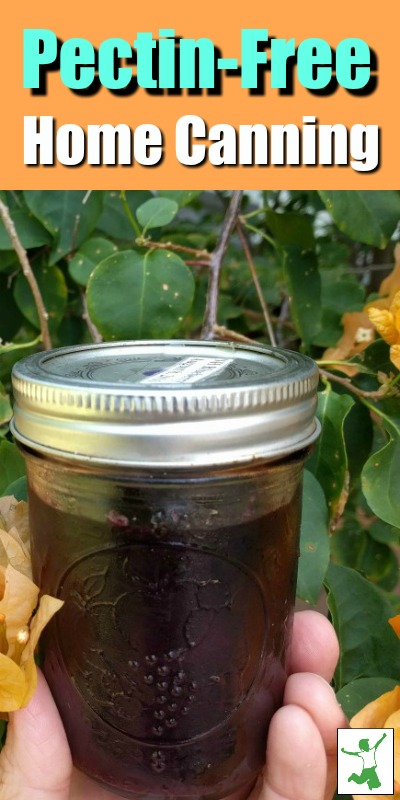Table of Contents[Hide][Show]

Pectin is an almost universal additive to commercially made jams and jellies. Even when homemade, this ingredient is commonly used to ensure a consistently gelled end result.
What many homemade jam and jelly enthusiasts don’t realize, however, is that pectin is not a desirable ingredient and should be avoided when an optimally healthy condiment is the goal.
The reasons are threefold.
Commercial Pectin
First, pectin can be made from corn and that usually means genetically modified corn unless the product is certified organic.
Even “all-natural” fruit versions are typically GMO based as they contain dextrose and citric acid, both corn-derived products. For example, take a look at the ingredients of Sure-Jell, a popular brand used by home canners:
Sure-Jell Ingredients: Dextrose, citric acid, fruit pectin.
While the fruit pectin itself isn’t a problem, the GMO dextrose and citric acid most definitely are.
Fruit Pectin Means High Sugar
Another reason to avoid commercial pectin is the amount of sugar that is required for it to work properly.
In order for commercial pectin to set, 55-85% of the jam or jelly must be sugar. This means that your homemade creation would contain more sugar than fruit!
Not exactly the type of spread you want your children using for breakfast toast before school for optimal learning and concentration.
Avoid Even Low Sugar Brands
What about low sugar versions, you may ask? This type of pectin binds with calcium instead of sugar to set properly and would allow the home canner to use much less sugar, no sugar, or a bit of stevia instead.
Low sugar pectins have the same problem as regular pectin in that they typically contain GMO ingredients. Here are the ingredients of low sugar Sure-Jell: (GMO corn) dextrose, fruit pectin, fumaric acid, sodium citrate.
While a low sugar brand like Pomona’s Universal Pectin uses only 100% citrus-derived ingredients, it, unfortunately, isn’t an organic product. Citrus trees are a highly sprayed crop with all manner of pesticides including a class of pesticides called cholinesterase inhibitors, known to be highly toxic to the nervous system. When citrus fruits arrive at the factory, the entire fruit is placed into the machines doing the processing – pesticides and all!
In addition, acid sprays are used to ensure that every drop of juice is extracted including the oil from the skin. These toxic residues (not listed on the ingredient label) are served up not just with commercial citrus juices, but additional products made with them such as citrus pectin.
Another lesser problem is that if you have hard water with high calcium content this may cause the jam to get overly firm, even rubbery.
Added Pectin?
Home canners, don’t despair! You don’t really need added pectin when making your favorite jam and jelly recipes.
The trick is to use fruit that is naturally high in pectin such as:
- Most apples
- Grapes
- Most berries
- Crabapples
- Currants
- Lemons
- Plums
- Raspberries
When making jam without added pectin, be sure to use fully ripe fruit only. Wash the fruit before cooking but do not soak. Remove stems, skins, and pits before cutting into pieces.
For jelly made without added pectin, select a mix of 3/4 ripe and 1/4 under-ripe fruit. Do not use commercially canned or frozen fruit juice as the pectin is too low. Crush soft, fully ripe fruits or berries and cut the firmer, under-ripe fruit into small pieces. Use the fruit peels and cores during cooking as this will add additional pectin.

Make Your Own!
If you feel that you really need to use pectin in your home canning efforts to ensure consistent results for the time spent, it is best to make your own to ensure a quality, GMO-free, pesticide-free product.
Here’s are the steps in a nutshell:
- Wash, but don’t peel about seven large tart ORGANIC apples. Granny Smith or crabapples work well.
- Cut the apples into pieces and add four cups of water and two tablespoons of organic lemon juice (fresh squeezed is ideal as it is higher in pectin than store-bought).
- Boil the mixture for 40 minutes, then strain it through an unbleached cheesecloth.
- Boil the juice for another 20 minutes, pour it into sterilized jars and seal.
- To test the pectin content of the concentrated juice, stir one tablespoon of grain or wood alcohol into one teaspoon of fruit juice. DO NOT TASTE! Juices that are high in natural pectin will form a lot of chunky gel. Those with an average pectin content will form a few pieces of the jelly-like substance. Low pectin juice that is low in pectin content will form only small, flaky pieces of sediment.
Knowing the pectin content of the final product will help you judge how much pectin to add to your homemade jam and jelly recipes which will vary with each batch of homemade pectin you produce.
Happy canning!
References
(1) Canning, Pickling and Freezing with Irma Harding
(2) Your Own Pectin Recipe
(3) Comparison of Low Sugar vs Traditional Pectin Recipe
More Information
How to Make Orangina








coupla questions?cholinesterase inhibitors, put ON the fruit. Does any actually get INTO the fruit? If so, what happens to it when the CI is heated during the process?? does it break down into something less noxious? More noxious? If it doesn’t get INTO the fruit in the first place, why is it’s use so objectionable?
I’m trying to make a tomato jam, would like to keep sugar to a minimum. Last time I made the no-pectin recipe I ended up with thickish syrup. (Seems low-sugar and jam are oxymoronic) If I settle for a thick syrup, could I use (evil gmo) corn starch as a thickener?
Just use a non-GMO corn starch and you should be fine. Or, consider arrowroot as a thickener instead.
Why must you avoid GMOs? The World Health Organization released a study showing that GMOs do not effect human health, and GMOs help reduce the amount of pesticides farmers have to use. Also, why organic apples? What is the difference between an organic apple vs a regular apple? Organic doesn’t mean pesticide-free.
The WHO isn’t exactly a credible source on this topic! Here is the research on what GMOs do to animals in scientific studies: https://www.thehealthyhomeeconomist.com/from-sterility-to-stomach-holes-11-scientific-reasons-why-you-must-avoid-gmos-now/
Wait. Citric acid comes from CORN?
I thought it came from citrus fruits?
I can’t seem to find any other information on this – would you mind posting a link about this?
Thank you so much!
Yes, most citric acid is derived from GMO corn.
I want to make some jam for canning but I want to take the seeds out first. Does pectin derive from the seeds at all or the other parts? I am using a pectin free recipe.
I have also found that organic bone gelatin is great for making a quick jam for the fridge by blending honey and fruit in a blender then add the bone gelatin. once heated, it becomes a fruit sauce for whatever you like fruit sauce on – but once back in the fridge firms back up to a jam. Thanks for the update on the pectin! I’m so ANTI GMO!
We never bought jams, jellies or preserves when I grew up. My mother made them from many fruits we grew at our summer home and never used pectin. I learned from her and have always made them from fresh fruit and sugar. I’m not sure how safe or healthy it is to use something made from animal bi-products in preserves or fruit sauce. ecially, if
I would rather use GMO than animall bone marrow. Yuck
Grateful for this information. My granddaughter is very allergic to corn
I have a question. I found a recipe for extracting whey from yogurt. As I try to do everything organic I purchased what I thought was a really good, clean brand. Only later, when I was trying to see what type of bacteria it contained did I see that the yogurt contained pectin.
But the question someone posed is does the pectin stay with the solids when extracting the whey? Therefore the whey will not contain any pectin at all? I feel there may be some type of residual in the whey but since pectin is used as a thickener the question is valid.
What do you think?
It is raspberry jam making time in our house. Your post is very informative and an enjoyable read. Thanks for sharing. I had my suspicions about pectin, but no facts to support my wariness. Well done!
Thank U for the info. I totally agree I never make my jams or jellies with pectin anymore. So against GMO’S that i will not ever use it again. I just make sure i get it to 220 and i use lemon.
We become so paranoid we have to spend hours and days each week on this type of stuff. Yes there are many foods that we should avoid, but a little pectin?
A little Pectin can ruin your stomach & BMs for days. Not fun to spend your time suffering, is it? Same goes for Citric Acid. I avoid like the plague. It’s in yogurt’s, pasta sauce, etc. Read the labels & avoid.
Know your enemy.